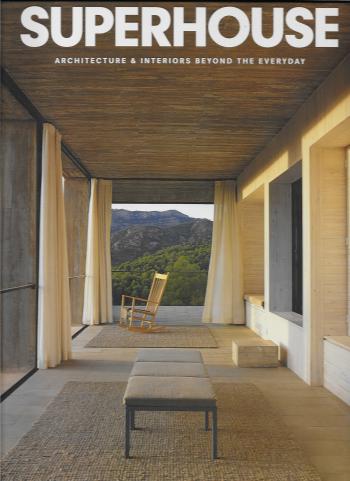Title: Superhouse; Architecture and interiors beyond the everyday
Author/s: Karen McCartney
Photographer/s: Richard Powers
ISBN: 978-1-92138-357-1
Size: 343mm x258mm, 330pp
Publisher: Penguin Group, Australia
Publisher www: http://www.penguin.com.au/

The problem with many books on architecture is that to get a sense of a house, you need to move around in it - enter the front door, move through the space, maybe even live there for years - before you can say that you have experienced it. Architecture is a three-dimensional art form that is difficult to capture on a two-dimensional page. The subjects of Superhouse; Architecture and interiors beyond the everyday have all been chosen as examples of this reality; houses that are first and foremost objects of design. To capture their personality is a mountainous task.
However, this book provides more than just an explanation and a peek into some of these innovative buildings defined by McCartney as “above all else…awe-inspiring” (1). This book, through a combination of expert architectural analysis and exquisite photography provided by Richard Powers, gives a real sense of the character and intentions behind each house, from the ‘Goulding Summerhouse’ (58) in County Wicklow, Ireland designed by Scott Tallon Walker Architects, to the ‘House in Country NSW’ (250) from Australian architect Virginia Kerridge.
The book is laid out very simply, with a short introduction from McCartney prefacing her visits to nineteen houses from around the world and talking with their designers and inhabitants about the features, intentions and stories of the buildings. Each separate experience is accompanied by a stunning layout of photographs taken by Powers to best showcase the unique combination of features that make the house a ‘superhouse’. The book concludes with a collection of design blueprints for included houses, allowing a further view into the design process.
The book has a singular, cohesive style tied together by the consistent photography from Powers, who visited each of the included houses with McCartney. Every single photograph shows a new aspect of the residence: sometimes grandiose, sometimes cheeky and always packed with atmosphere. Powers has an incredible ability to find the details that make each of these houses unique and “awe-inspiring” and bring them to the reader through the large, often full- or double-page photographs. As far as invitations to explore go, Superhouse practically begs the reader to leaf through, with every page a window into a singular design sensibility.
Wood is used in each of the houses included in the book, either incorporated into the interiors and exteriors to provide warmth and contrast to harsher stone or concrete, as in the Brazilian Masetti House (178), or relied upon as an integral part of the structure such as in the Trunk House (166) from the Central Highlands of Victoria. The Trunk House is notable for its use of wood, as the use of unmilled eucalypt trunks as exterior support columns manages to blend the house into the surrounding forest, creating an effect of invisibility and showing a visible proof of the architect’s affirmation to sustainable building practices.
And those practices are a common theme with all of the architects interviewed by McCartney. All of the houses have been built or at least significantly restored within the last 40 years with a strong emphasis placed on sustainable construction, respecting the surrounding environments and creating a house to be lived in by real people. Many of the interviews with the architects showcase the trust shared between them and the commissioning clients, and interviews with current residents illuminate the respect afforded to their dwellings.
There is a deliberate focus by McCartney to include both Australian and international buildings, as her life and studies in Australia have left her with a strong appreciation for the architecture undertaken here, particularly in the south-eastern region of Victoria and NSW. Over twenty per cent of the featured houses are Australian with the remainder spread between North and South America, Europe, North Africa and New Zealand. It is a refreshing experience to see such an emphasis placed upon innovative architecture from our own home country.
Superhouse is a decadent read. McCartney and Powers have created a book that oozes sensuality and atmosphere, having a design sensibility equal to the houses examined within itself. This book feels and reads like a guilty pleasure and, while it does provide expert analysis on the houses and building practices included within its pages, it is overwhelmingly a sensual experience.
